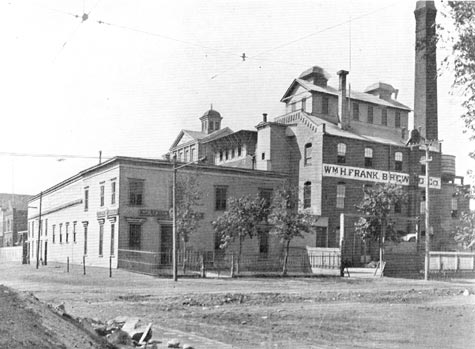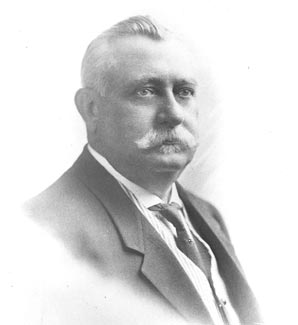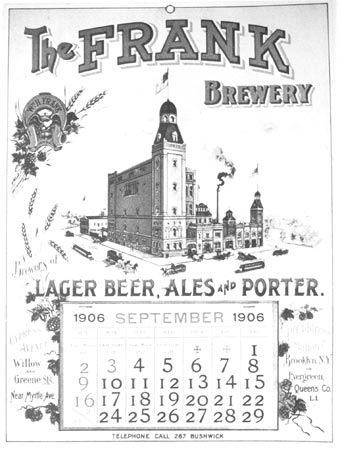



FRANK BREWERY
AKA: Enterprise Brewery City Brewing Company Greater New York BreweryThe William H. Frank Brewing Company was located in Ridgewood, on the southwest side of Cypress Avenue between Greene Street (now known as Hancock Street) on the north and Willow Street (now Weirfield Street) on the south. This 1897 photo was taken from the northeast side of Cypress Avenue and Willow Street. It was founded in 1867 by Jacob MARQUARDT. He died in 1880 and in 1884 his widow sold the brewery to Gustave FEIGENSPA for $85,000. In 1892 FEIGENSPA sold the brewery to William FRANK. In 1874, Jacob Marquardt hired Charles Zerwick to be the bewmeister of his brewery. In Three years later, Charles Zerwick married Amelia Welz, daughter of John Welz, the owner of the Welz Brewery on the southeast corner of Myrtle and Wyckoff avenues in Ridgewood. He continued to work for Marquardt. In May 1878, a fire destroyed the Marquardt Brewery. It took months to rebuild the brewery and get it back in operation. During this interim period, John Welz offered Charles Zerwick the position of brewmeister at his brewery and Zerwick accepted.
William H. Frank, as photographed in 1912, was president of the Ridgewood brewery that bore his name. He also served as a director of the Ridgewood National Bank and the Prudential Savings Bank. Eventually, Jacob Marquardt rebuilt his brewery and got it back in operation. But in the summer of 1880, he became ill from dropsey and he passed away on Aug. 17, 1880. Marquardt did not leave a will. To complicate matters, he had relatives in Germany who, according to the laws of New York State, were entitled to share in his estate. Henricke Marquardt, his widow, assumed the position of manager of the brewery and it continued in operation but the estate was not settled. In 1883, Federal Revenue agents seized the brewery, charging the Marquardt Brewery with shipping kegs of beer without the revenue stamp pasted over the bung hole on the keg. An investigation revealed that some of the employees of the brewery were stealing filled kegs and using the brewery’s wagon to deliver the untaxed kegs to saloons. Gustave Feigenspan had indicated an interest in buying the brewery. Mrs. Marquardt worked out an agreement to lease the brewery to him until the estate was settled. With the lease, the name of the brewery was changed to Feigenspan Brewing Company. With the cooperation of the United States Envoy stationed in one of the large German cities who certified the signatures on the document, the estate was settled in 1887 and the brewery was sold to Gustave Feigenspan for $80,000. In 1889, Feigenspan Brewing Company shipped 39,000 barrels of beer. Encouraged by these sales, Mr. Feigenspan announced that he was expanding the annual capacity to 50,000 barrels (31 gallons per bbl). In the late 1880s and early 1890s in Great Britain, a group of investors formed a syndicate (the United States Brewing Company, Ltd.) to acquire some American breweries and market beer in the United States. Over a period of several years, they acquired six American breweries. The Frank Brewery’s calendar for 1906.
As per the second phase of their plan, they cut prices to increase their share of market. As a result of the price war they started, a half-barrel was sold by the syndicate for $3.50 and an 1/8 barrel, which was popular for the picnic trade, sold for $1. Many of the picnic parks were owned by breweries. Families on a Sunday afternoon would go to a picnic park, pick out a table and order an 1/8 keg for $1. An 1/8 keg held about 60 eight-oz. glasses. In addition, some parks gave the customer a free supply of pretzels. In the fall of 1892, William H. Frank, who worked for the Feigenspan Brewing Company, formed a group of investors to buy the business. Discouraged by the lack of profits, the British syndicate was dissolved and they sold off their American breweries. The Feigenspan Brewing Company was renamed the William H. Frank Brewing Company. In March 1893, Philip Geyer, Sr. joined the William H. Frank Brewery as brewmeister and as an investor. He had been the brewmeister at the Ebling Brewery in Manhattan. In 1897-98, the brewery was substantially expanded to 150,000 barrels (31 gallons per bbl.) annually. The new malt tower on the southwest corner of Cypress Avenue and Weirfield Street was 180’ high and it became a Ridgewood landmark. In addition, on the west side of Cypress Avenue from Weirfield Street on the north to Centre Street on the south, a cooperage and a bottling plant were installed. The name of the brewery was shortened to the Frank Brewery. As was the custom with most of the breweries in the area, in 1899 a saloon and summer garden were opened on the brewery property. In 1901, William Werner was the proprietor of this saloon. From 1903 through 1912, Louis Kress was the proprietor. In 1916, William Frank became ill. On July 16, the name of the brewery was changed to Enterprise Brewery. Apparently a change in owners had taken place. William H. Frank died on Dec. 1, 1917. Prohibition started in January 1920. The Enterprise Brewery produced malt extracts for the home brewing trade and also near beer. In 1924, with a substantial amount of space not being utilized in the brewery. an effort was made to rent some of the space. The Evans Dairy became a tenant. Prohibition was an unpopular law and in 1928, the Paulsen family, who had operated a brewery prior to Prohibition, decided to buy the Enterprise Brewery and renamed it City Brewing Corporation. They had to be patient, as Prohibition only ended in December 1932. They then purchased some new brew kettles and expanded the plant, featuring Tally-Ho and then Koenig’s Beer, named for the president of City Brewing, John Koenig. In 1941, the name of the brewery was changed to the Greater New York Brewery, Inc. In 1948, the Brewery Workers Union struck all 17 breweries in the City of New York. This was an unfortunate move as it gave the out-of-town brewers an opportunity to break into the big New York City market. For the first time, customers in their local taverns saw labels such as Fitzgerald and priors on the beer taps. In 1949, the union struck again and as a result, a number of the local brewers closed down, including Greater New York in 1950. Purvis Inc., a manufacturer of syrups for the bakery and tobacco trades, moved into the plant and were there until 1959.
Remembered today as the Frank Brewery, the complex of buildings on Cypress Avenue was renamed more than once before it ceased operation as the Greater New York Brewery, Inc. in 1950. In the spring of 1959, the buildings were demolished. Ridgewood Times Archives Back To BUSINESS Main Return to BROOKLYN Info Main Page